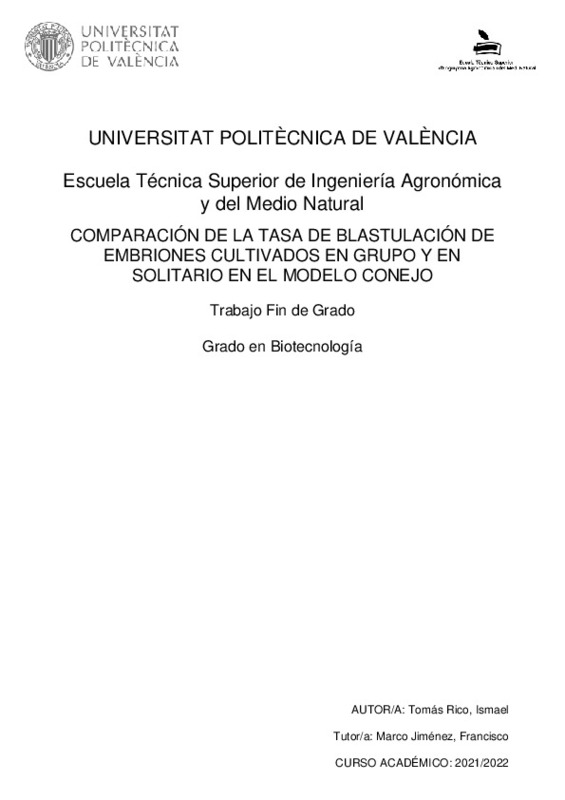|
Resumen:
|
[EN] The development of artificial intelligence in embryology through the application of timelapse imaging technology is making a transition to individualized culture since it provides the
ability to select the most ...[+]
[EN] The development of artificial intelligence in embryology through the application of timelapse imaging technology is making a transition to individualized culture since it provides the
ability to select the most suitable embryo to be transferred. Nevertheless, one of the current
doubts of the scientific community is that in vitro culture in human is carried out individually,
given that most of the studies carried out indicate that the results of group culture seem to be
more advantageous in terms of embryo development and quality. Most studies have been based
on tests in the murine model, despite its not being the most suitable animal model for
embryology and reproductive biology studies. There are models more similar to human
reproduction from which results can be extrapolated, such as the rabbit, however, to our
knowledge, in vitro culture has not yet been studied individually on this model.
The objective of this work has been to evaluate the effect of in vitro embryo culture,
individually or in groups, on in vitro development and on the capacity for implantation and birth
using the rabbit model. For this, 10 nulliparous females were used as donors, obtaining 409
embryos. The embryos were placed in culture conditions, in groups (n=10) or individually (n=1),
and maintained for 72 hours. After this period, development was evaluated and those that had
reached the blastocyst stage (n=200) were transferred to 10 recipient females by laparoscopy.
The assessment of embryonic implantation was performed by laparoscopy at day 12 of
gestation. Finally, after birth, the number of animals born was determined. The individually in
vitro culture presented significant differences when compared to group culture. Specifically, the
blastulation rate of embryos cultured individually was higher (+12.6%) than that of group
cultured (P= 0.03). Regarding in vivo development, no significant differences were observed (P=
0.881) neither in the implantation rate (33% vs 34%, for individual and in group, respectively)
nor in the birth rate (20% vs 25%, for individual and in group, respectively) of both experimental
groups. For all these reasons, our results indicate that the rabbit model is ideal for carrying out
studies that require the use of individualized in vitro culture for early embryos, since these do
not present any difference in development neither in vitro nor in vivo.
[-]
[ES] Los métodos de cultivo de embriones han evolucionado notablemente en los últimos 30 años. No obstante, los estudios indican que los embriones cultivados en un sistema de cultivo en grupo (25-200 embriones en volúmenes ...[+]
[ES] Los métodos de cultivo de embriones han evolucionado notablemente en los últimos 30 años. No obstante, los estudios indican que los embriones cultivados en un sistema de cultivo en grupo (25-200 embriones en volúmenes variables entre 50-400 μl) tienen una mayor capacidad de desarrollo que los embriones cultivados individualmente o en pequeños grupos. Sin embargo, en humano el cultivo de embriones se lleva a cabo de forma individual, ya que esto permite una valoración más detallada. Por ello, para un uso adecuado de modelos animales sería necesario llevar a cabo experimentos en busca del modelo más adecuado para la extrapolación de resultados a humano. El modelo animal más empleado es el ratón, si bien, este no es el más idóneo para los estudios reproductivos. En este trabajo se pretende comparar el desarrollo de embriones tempranos de conejo en dos situaciones; (i) cultivados en grupo y (ii) cultivados de forma individualizada. Para ello, se emplearán alrededor de 10 conejas, de los que se obtendrán un mínimo 100 embriones por grupo. Para reducir el uso de animales, se empleará un tratamiento de superovulación (FSH-recombinante similar al empleado en humano). A las 72 horas se inseminarán artificialmente con machos de probada fertilidad. A las 24 horas se obtendrán los embriones en estadio de 2 células, y serán divididos de forma aleatoria en los dos grupos experimentales: (i) cultivados en grupos de 10 en un volumen de 300 μl del medio SAGE 1-STEP (Origio), y (ii) cultivados de forma individualizada en 30 μl, en condiciones estándar (38ºC, 5%CO2 en humedad saturada). A las 72 horas de cultivo se evaluará el porcentaje de embriones que alcancen el estadio de blastocisto.
[-]
|







